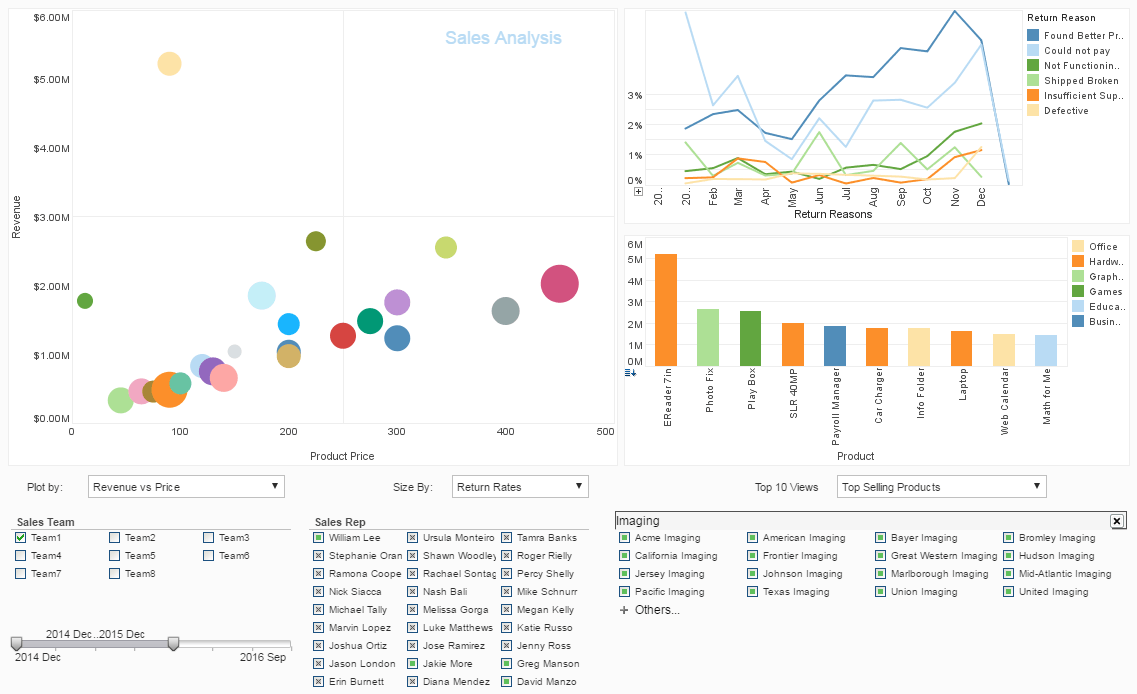What Is a Serverless Dashboard?
A serverless dashboard is a cloud-native solution for visualizing and analyzing data that doesn't require you to manage any infrastructure. Unlike traditional BI tools that demand costly server provisioning and maintenance, serverless dashboards run entirely on a scalable backend managed by the cloud provider or BI vendor. You only pay for usage—no fixed costs, no hardware, and no DevOps headaches.
Why Go Serverless for Business Dashboards?
Serverless analytics platforms are revolutionizing how teams deploy dashboards, especially for real-time metrics, customer-facing analytics, and embedded data visualizations. Here’s what makes a serverless dashboard solution stand out:
- Instant Deployment: Launch dashboards without provisioning servers or databases.
- Auto-Scaling: Handle thousands of users or queries without performance degradation.
- Zero Maintenance: No patching, server tuning, or manual scaling needed.
- Usage-Based Pricing: Pay only for what you use—ideal for startups and SaaS providers.
- Global Availability: Deployed across cloud regions for optimal latency and reliability.
- Secure by Design: Built-in data encryption, role-based access, and audit logs.
Key Features of Our Serverless Dashboard Platform
- No-Code Dashboard Builder: Drag-and-drop interface to build advanced visualizations quickly.
- Real-Time Data Refresh: Live connections to your cloud databases, APIs, or streaming data.
- Fully Customizable UI: Match your brand with white-labeling and theme control.
- Embedded Analytics: Seamlessly embed dashboards into SaaS apps or partner portals with full interactivity.
- API-Driven Integration: Automate dashboard generation, data sync, and user control via REST APIs.
- Multi-Tenant Support: Serve dashboards to multiple clients or teams from a single environment.
Use Cases
Our serverless dashboard solution is ideal for a wide range of business needs:
- SaaS Companies: Deliver embedded dashboards without backend overhead.
- Marketing Teams: Track campaigns in real-time with external data sources.
- Product Teams: Visualize usage metrics, retention, and engagement KPIs.
- Operations: Monitor logistics, IoT sensors, or supply chain health.
- Executives: Get a unified view of business performance with mobile-friendly dashboards.
Scalable and Serverless from Day One
Whether you’re serving five users or fifty thousand, our serverless architecture ensures performance stays consistent. There’s no infrastructure for you to monitor or scale. All dashboards are delivered over a globally-distributed network to ensure low latency and high availability.
Frequently Asked Questions
What makes your dashboard solution serverless?
We eliminate the need for server provisioning, scaling, or updates by leveraging cloud-native, event-driven infrastructure. Dashboards run on-demand and scale automatically with traffic.
Can I embed dashboards in my SaaS application?
Yes. You can embed dashboards using iframe, JavaScript SDK, or full API control. You can also enable SSO and row-level security per user.
Does it support real-time data?
Absolutely. Connect live to cloud databases, REST APIs, or streaming data pipelines for real-time updates with no reload required.
Is this solution suitable for enterprises?
Yes. We offer enterprise-grade compliance, auditing, user management, and high availability across multiple regions.
Which Dashboard Vendors Provide Serverless Solutions?
Here is a list of notable dashboard vendors that offer serverless or serverless-like business intelligence (BI) solutions. These platforms allow organizations to deploy dashboards without managing infrastructure, with features like automatic scaling, usage-based pricing, and cloud-native architecture.
1. StyleBI
- Type: Fully serverless, microservice-based BI
- Features:
- No server or database management required
- Real-time, embedded dashboards
- REST API-driven, white-labeling support
- Ideal for SaaS, multi-tenant, and embedded analytics
- Strengths: Extremely lightweight deployment, scalable embedding, customizable visual themes
- Weakness: Limited brand awareness compared to major enterprise BI tools, which may affect procurement in large corporations.
2. Google Looker Studio (formerly Data Studio)
- Type: Serverless by design (fully hosted by Google)
- Features:
- No setup or infrastructure management
- Integrates with Google BigQuery, Sheets, Ads, and more
- Free with Google account
- Strengths: Easy for teams using Google Cloud or Workspace; basic serverless dashboarding
- Weakness: Limited data modeling and transformation capabilities for complex enterprise use cases.
3. Amazon QuickSight
- Type: Cloud-native, serverless BI from AWS
- Features:
- Auto-scalable compute (SPICE engine)
- Pay-per-session pricing
- ML insights and embedded analytics
- Strengths: Deep integration with AWS ecosystem; robust security and compliance
- Weakness: Learning curve and user experience may feel less intuitive compared to other modern BI tools.
4. Microsoft Power BI (Premium with Fabric)
- Type: Semi-serverless (Fabric architecture and Power BI Embedded)
- Features:
- Serverless compute with Microsoft Fabric integration
- DirectQuery and real-time streaming options
- Embeddable in custom portals and SaaS apps
- Strengths: Works well for enterprise users already in Microsoft ecosystem
- Weakness: Serverless features require advanced licensing tiers and can become costly at scale.
5. Redash (hosted)
- Type: Lightweight hosted solution (with serverless deployment options via cloud providers)
- Features:
- Connects to dozens of data sources
- Query editor + dashboard builder
- Simple hosted plans reduce infrastructure burden
- Strengths: Ideal for SQL-savvy users; straightforward visualization and sharing
- Weakness: Basic visualization options; not ideal for highly polished or interactive dashboards.
6. Superset (Serverless Deployments on Managed Platforms)
- Type: Open-source (can be made serverless via managed services like Astronomer or Render)
- Features:
- Visualization-rich dashboards
- Cloud-native deployment possible with containers
- Strengths: Powerful if integrated in a modern devops workflow
- Weakness: Requires DevOps knowledge for deployment and customization unless using a third-party host.
7. Lightdash (Cloud-Hosted Version)
- Type: Serverless deployment through hosted offering
- Features:
- DBT-native dashboarding
- Interactive queries, charts, and access control
- Strengths: Built for modern data stacks using dbt and cloud warehouses
- Weakness: Depends heavily on dbt; not ideal for teams without a dbt-based data stack.
8. Klipfolio
- Type: Cloud-hosted, low-maintenance BI tool
- Features:
- Hosted dashboards with live data connections
- Custom formulas and embedded capabilities
- Strengths: Great for agencies, SMEs, and business teams needing fast setup
- Weakness: Limited scalability for complex multi-tenant or large enterprise deployments.



